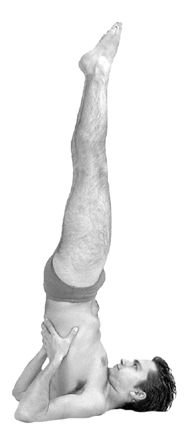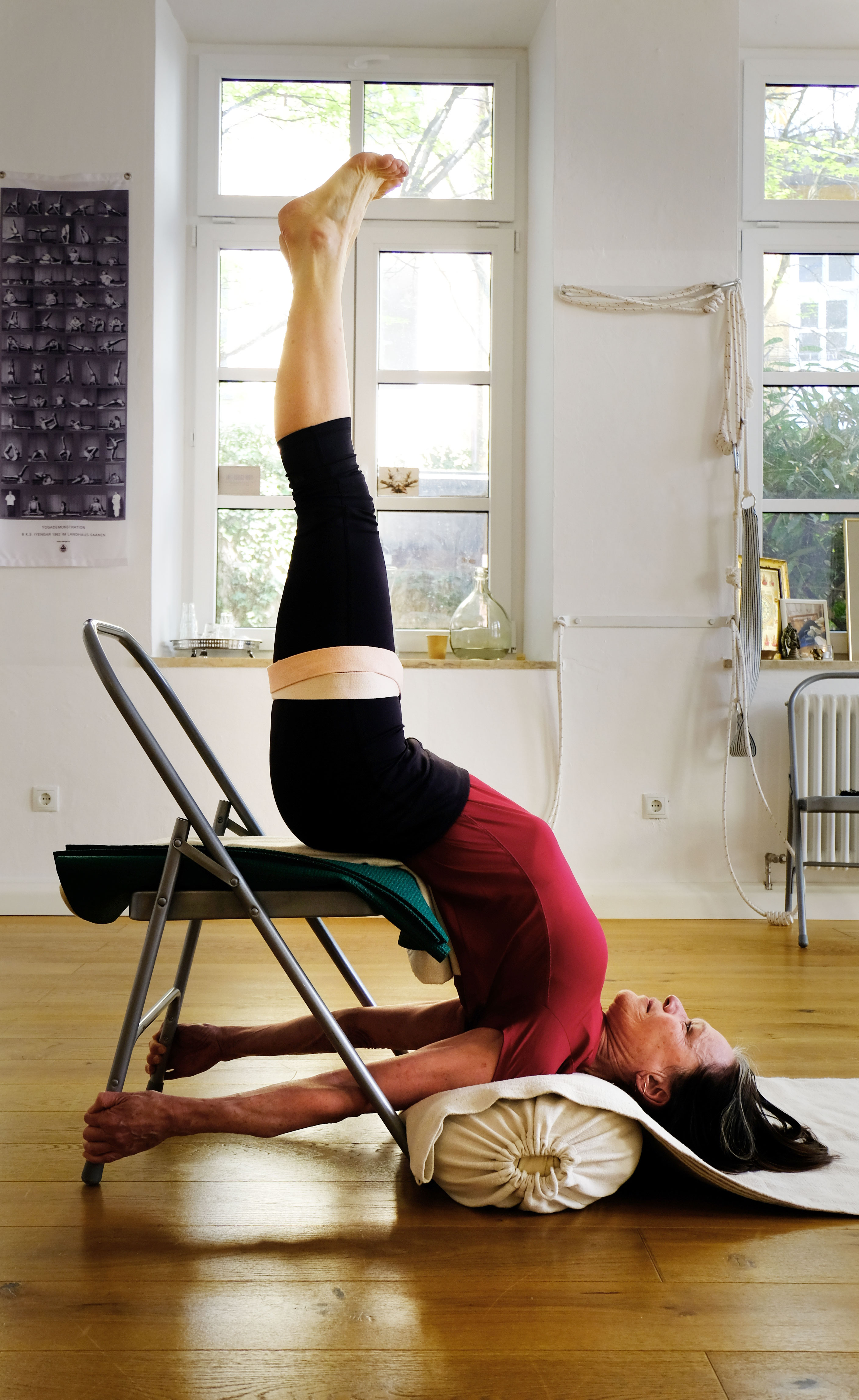Introduction
 |
Joseph RENGER, CC BY-SA 3.0, via Wikimedia Commons Shoulder Stand Pose |
Sometimes called the “Queen of Asanas,” Sarvangasana is a full-body workout in a single posture, improving physical health, mental clarity, and emotional balance.
This inverted posture is a gem from the Hatha Yoga tradition and has been practiced for centuries for its rejuvenating and therapeutic effects.
When performed correctly, it channels energy to the upper body, enhances circulation, strengthens muscles, and improves hormonal balance.
Meaning of Sarvangasana—The Shoulder Stand Pose
The philosophy of Sarvangasana lies in its name. “All limbs” signifies that almost every muscle, joint, and organ is influenced during its practice. It is not just an exercise but a holistic technique that engages:
-
Muscles—from the shoulders and back to the core and legs.
-
Organs—improving blood flow to the brain, thyroid, lungs, and heart.
-
Mind—encouraging calmness, focus, and inner peace.
Ancient yoga texts praise inversion poses for their ability to reverse the effects of gravity on the body and mind. Sarvangasana is considered the perfect example of such inversion, bringing balance and restoration.
Preparation for Sarvangasana—The Shoulder Stand Pose
Before attempting Sarvangasana, it’s essential to prepare the body with warm-up poses. Beginners should avoid jumping straight into this advanced posture without building flexibility and strength.
Recommended Preparatory Poses:
-
Setu Bandhasana (Bridge Pose)—strengthens the back, hips, and shoulders.
-
Viparita Karani (Legs Up the Wall Pose)—gently introduces inversion benefits.
-
Halasana (Plow Pose)—increases spinal flexibility and opens the shoulders.
-
Bhujangasana (Cobra Pose)—stretches the spine and chest.
By practicing these, the body becomes more comfortable with the shoulder support and spinal alignment needed for Sarvangasana.
Step-by-Step Guide to Performing Sarvangasana—The Shoulder Stand Pose

Marcocarvalho,
CC BY 3.0,
via Wikimedia
Commons

CC BY 3.0,
via Wikimedia
Commons
Step 1: Starting Position
-
Lie flat on your back on a yoga mat.
-
Keep your legs together, arms resting beside the body, palms facing down.
-
Relax the neck and shoulders completely.
Step 2: Leg Lift
-
Inhale deeply and slowly lift both legs upward to a 90° angle.
-
Use your abdominal muscles for control.
Step 3: Lifting the Hips and Back
-
Place your palms on the mat for support.
-
Exhale slightly, bend the knees toward your chest, and roll your hips upward.
-
Support your lower back with both hands, elbows firmly on the mat.
Step 4: Straightening the Legs
-
Once the hips are above the shoulders, extend both legs straight up toward the ceiling.
-
Your body should form a straight line from shoulders to toes.

Marcocarvalho, CC BY 3.0,
via Wikimedia Commons
Step 5: Alignment and Breathing

Marcocarvalho, CC BY 3.0,
via Wikimedia Commons
-
Keep your chin tucked slightly toward the chest to protect the neck.
-
Breathe deeply and steadily.
-
Hold the pose for 30 seconds to 3 minutes, depending on comfort level.
Step 6: Coming Down Safely
-
Slowly bend the knees toward your forehead.
-
Gradually lower your spine and hips back to the mat, keeping control.
-
Finish by resting in Shavasana for complete relaxation.
Alignment Tips for Beginners
-
Use a folded blanket under the shoulders to prevent neck strain.
-
Keep elbows shoulder-width apart.
-
Avoid pressing the head into the floor; weight should be on the shoulders and arms.
-
Do not hold the breath—steady breathing maintains balance.
Benefits of Sarvangasana—The Shoulder Stand Pose
Sarvangasana is known for its transformative effects on the body and mind.
1. Improves Blood Circulation
The inversion directs fresh blood to the brain, improving concentration, memory, and mental alertness.
2. Stimulates Thyroid and Parathyroid Glands
By gently compressing the neck area, this pose activates the thyroid and parathyroid glands, helping regulate metabolism and calcium balance.
3. Enhances Immune Function
Better circulation means more oxygen and nutrients delivered to cells, boosting immunity.
4. Relieves Nasal Congestion and Sore Throat
Increased blood flow to the upper respiratory system can help reduce congestion and soothe throat discomfort.
5. Strengthens Back and Shoulders
Holding the posture engages the spine, shoulder muscles, and core, improving posture and reducing back pain.
6. Reduces Stress and Insomnia
The calming inversion helps release tension, making it easier to fall asleep.
Precautions and Contraindications
While Sarvangasana is highly beneficial, it is not suitable for everyone. Avoid this pose if you have:
-
High blood pressure
-
Serious neck or spine issues
-
Heart problems
-
Glaucoma or ear problems
-
Recent surgery
-
Menstruation or pregnancy
Tip: Always consult a yoga instructor or healthcare provider before attempting Sarvangasana if you have health concerns.

Kaethe17, CC BY-SA 4.0,
via Wikimedia Commons

Kaethe17, CC BY-SA 4.0,
via Wikimedia Commons
Variations of Sarvangasana—The Shoulder Stand Pose
[A German Yoga Teacher Demonstrating Sarvangasana Using a Chair, Yoga Mat, Belt, Blanket, and Bolster]
Supported Shoulder Stand (using props)—Ideal for beginners or those with neck sensitivity.
-
Niralamba Sarvangasana (Unsupported Shoulder Stand)—An advanced version without hand support.
Eka Pada Sarvangasana (One-Leg Shoulder Stand)—Challenges balance and strengthens core muscles.
Yoga Sequence Incorporating Sarvangasana—Shoulder Stand Pose
A well-structured yoga session may include:
-
Warm-up stretches (5–7 minutes)
-
Bridge Pose
-
Plow Pose
-
Shoulder Stand (Sarvangasana) – 1–3 minutes
-
Fish Pose (Matsyasana)—counter-pose to relieve neck strain
-
Relaxation in Shavasana
Sarvangasana in Daily Life
Incorporating Sarvangasana into a daily yoga routine can improve long-term health. With just 2–5 minutes a day, practitioners can enjoy:
-
Sharper focus at work or study
-
Better hormonal balance
-
Relief from chronic back stiffness
-
Enhanced mood and emotional stability
Common Mistakes to Avoid
-
Placing too much weight on the neck instead of the shoulders
-
Allowing elbows to splay out
-
Rushing into or out of the posture
-
Holding the breath instead of steady breathing
-
Practicing without adequate warm-up
Conclusion
Sarvangasana truly lives up to its title as the “Queen of Asanas.” By engaging all parts of the body and calming the mind, it delivers a complete package of health benefits. With regular, mindful practice, it can transform posture, improve circulation, enhance immunity, and bring a deep sense of inner peace.
Beginners should start slowly, focus on proper alignment, and use props if needed. Over time, this asana can become a powerful daily ritual for holistic wellness.
No comments:
Post a Comment